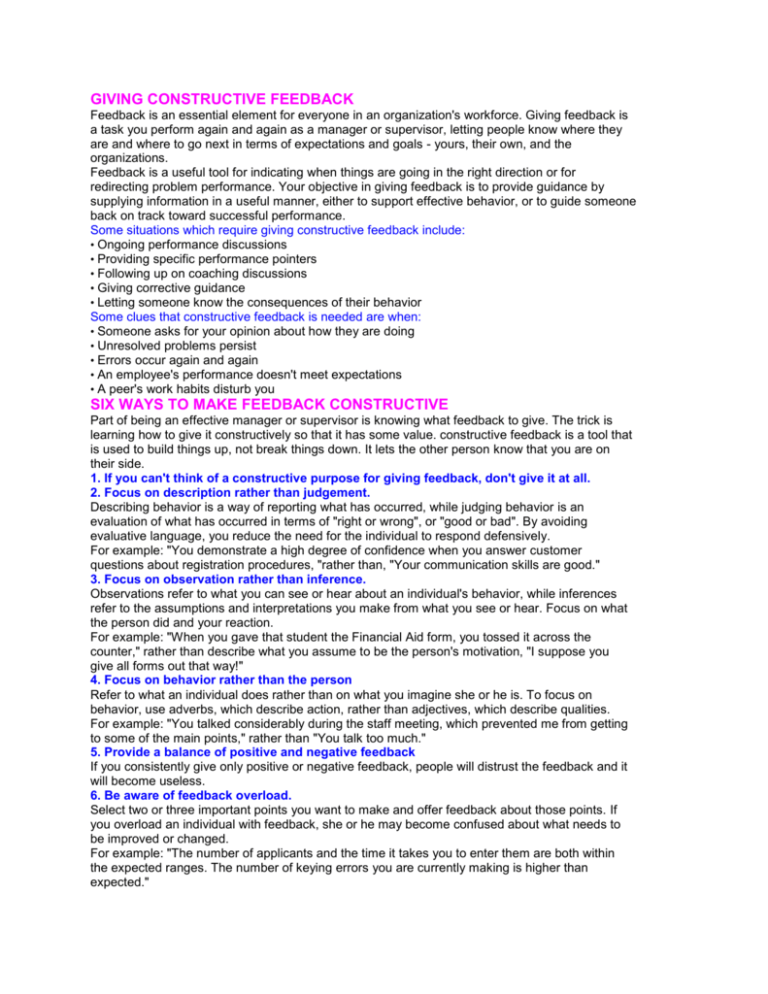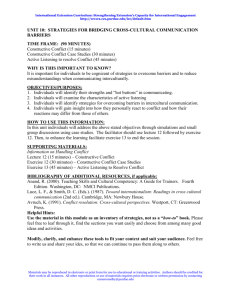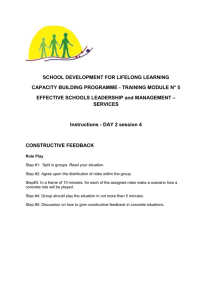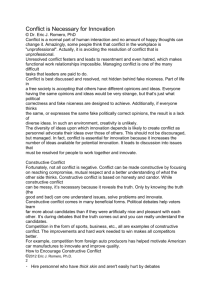GIVING CONSTRUCTIVE FEEDBACK Feedback is an essential
advertisement

GIVING CONSTRUCTIVE FEEDBACK Feedback is an essential element for everyone in an organization's workforce. Giving feedback is a task you perform again and again as a manager or supervisor, letting people know where they are and where to go next in terms of expectations and goals - yours, their own, and the organizations. Feedback is a useful tool for indicating when things are going in the right direction or for redirecting problem performance. Your objective in giving feedback is to provide guidance by supplying information in a useful manner, either to support effective behavior, or to guide someone back on track toward successful performance. Some situations which require giving constructive feedback include: • Ongoing performance discussions • Providing specific performance pointers • Following up on coaching discussions • Giving corrective guidance • Letting someone know the consequences of their behavior Some clues that constructive feedback is needed are when: • Someone asks for your opinion about how they are doing • Unresolved problems persist • Errors occur again and again • An employee's performance doesn't meet expectations • A peer's work habits disturb you SIX WAYS TO MAKE FEEDBACK CONSTRUCTIVE Part of being an effective manager or supervisor is knowing what feedback to give. The trick is learning how to give it constructively so that it has some value. constructive feedback is a tool that is used to build things up, not break things down. It lets the other person know that you are on their side. 1. If you can't think of a constructive purpose for giving feedback, don't give it at all. 2. Focus on description rather than judgement. Describing behavior is a way of reporting what has occurred, while judging behavior is an evaluation of what has occurred in terms of "right or wrong", or "good or bad". By avoiding evaluative language, you reduce the need for the individual to respond defensively. For example: "You demonstrate a high degree of confidence when you answer customer questions about registration procedures, "rather than, "Your communication skills are good." 3. Focus on observation rather than inference. Observations refer to what you can see or hear about an individual's behavior, while inferences refer to the assumptions and interpretations you make from what you see or hear. Focus on what the person did and your reaction. For example: "When you gave that student the Financial Aid form, you tossed it across the counter," rather than describe what you assume to be the person's motivation, "I suppose you give all forms out that way!" 4. Focus on behavior rather than the person Refer to what an individual does rather than on what you imagine she or he is. To focus on behavior, use adverbs, which describe action, rather than adjectives, which describe qualities. For example: "You talked considerably during the staff meeting, which prevented me from getting to some of the main points," rather than "You talk too much." 5. Provide a balance of positive and negative feedback If you consistently give only positive or negative feedback, people will distrust the feedback and it will become useless. 6. Be aware of feedback overload. Select two or three important points you want to make and offer feedback about those points. If you overload an individual with feedback, she or he may become confused about what needs to be improved or changed. For example: "The number of applicants and the time it takes you to enter them are both within the expected ranges. The number of keying errors you are currently making is higher than expected." Giving feedback constructively benefits everyone. You, as the manager or supervisor, use the ongoing exchange of information as a way of getting to know your people and providing them with valuable guidance in their work. The employee, manager, supervisor, or peer receives data that makes that makes her or his job go easier. The organization gains in improved productivity of its workforce. THE SIX STEP METHOD FOR GIVING CONSTRUCTIVE FEEDBACK Step 1: State the constructive purpose of your feedback. State your purpose briefly by indicating what you'd like to cover and why it's important. If you are initiating feedback, this focus keeps the other person from having to guess what you want to talk about. If the other person has requested feedback, a focusing statement will make sure that you direct your feedback toward what the person needs. For example: "I have a concern about." "I feel I need to let you know." "I want to discuss." "I have some thoughts about." Step 2: Describe specifically what you have observed. Have a certain event or action in mind and be able to say when and where it happened, who was involved, and what the results were. Stick to what you personally observed and don't try to speak for others. Avoid talking vaguely about what the person "always" or "usually" does. For example: "Yesterday afternoon, when you were speaking with Mrs. Sanchez, I noticed that you kept raising your voice." Step 3: Describe your reactions. Explain the consequences of the other person's behavior and how you feel about it. Give examples of how you and others are affected. When you describe your reactions or the consequences of the observed behaviors, the other person can better appreciate the impact their actions are having on others and on the organization or team as a whole. For example: "The staff member looked embarrassed and I felt uncomfortable about seeing the episode." "Shouting at our students is not acceptable behavior in this department." Step 4: Give the other person an opportunity to respond. Remain silent and meet the other persons eye, indicating that you are waiting for answer. If the person hesitates to respond, ask an open ended question. For example: "What do you think?" "What is your view of this situation?" "What are your reaction to this?" "Tell me, what are your thoughts?" Step 5: Offer specific suggestions. Whenever possible make your suggestions helpful by including practical, feasible examples. Offering suggestions shows that you have thought past your evaluations and moved to how to improve the situation. Even if people are working up to expected standards, they often benefit from ideas that could help them to perform better. If your feedback was offered supportively or neutrally, in the "for your information" mode, or depending on the situation's circumstances, suggestions may not be appropriate. Use your common sense and offer an idea if you think the other person will find it useful. Don't drum up a suggestion for improvement just for the sake of it. For example: "Jennifer, I sometimes write myself notes or put up signs to remind myself to do something." "Jill, rather than telling Ed that you're not interested in all the details, you might try asking him specific questions about the information you are most interested in." Step 6: Summarize and express your support Review the major points you discussed. Summarize the Action items, not the negative points of the other person's behavior. If you have given neutral feedback, emphasize the main points you have wanted to convey. For corrective feedback, stress the main things you've discussed that the person could do differently. End on a positive note by communicating confidence in the person's ability to improve the situation. For example: "As I said, the way the group has figured out how to cover phone calls has really lessened the number of phone messages to be returned. You've really followed through on a tough problem. Please keep taking the initiate on problems like that. By summarizing, you can avoid misunderstandings and check to make sure that your communication is clean. This summary is an opportunity to show your support for the other person—a way to conclude even an negative feedback situation on a positive note. For example: "At least we understand each other better since we've talked. I'll do what I can to make sure your priorities are factored into the schedule, and I'll expect you to come straight to me if the schedule is a problem. Note: Information on Recognizing Good Performance, Characteristics of Good Recognition, Coaching: An Approach to Solving Performance Problems, and Giving Constructive Feedback provided courtesy of Enrollment Services Training, Staff Development and the Work-Study Office, Boston University.











